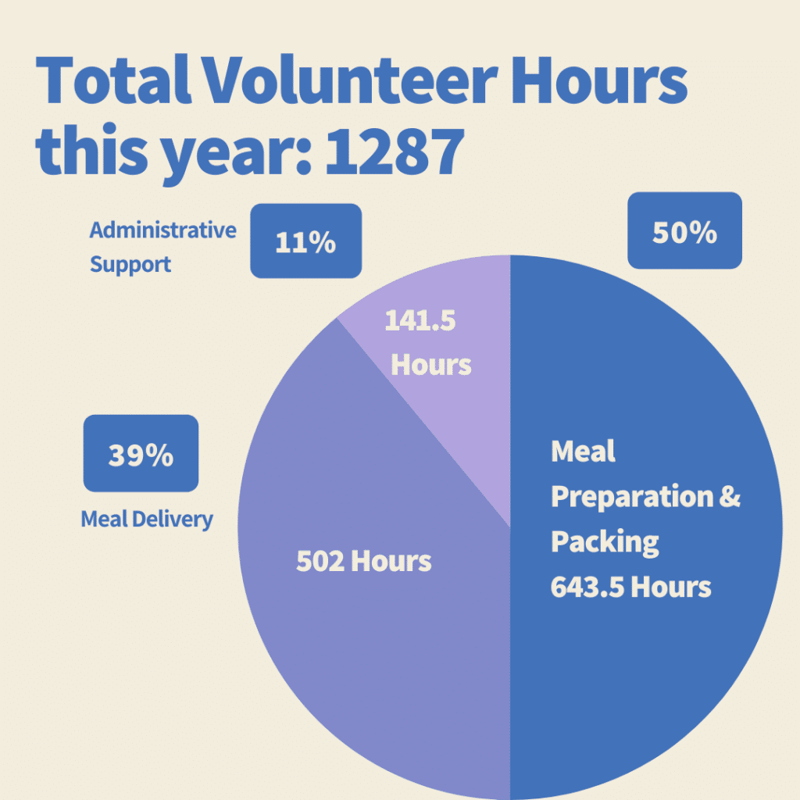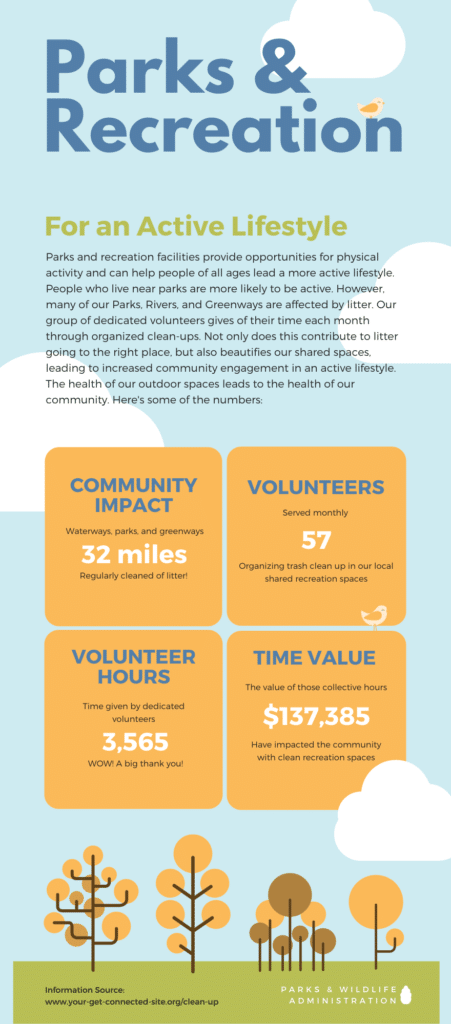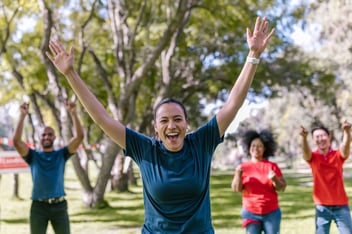Your volunteers are a vital piece of the puzzle when it comes to making your organization’s mission a reality. Many organizations routinely report volunteer impact to funders, their board of directors, and corporate partners. However, it’s just as important to share volunteer impact directly with your volunteers.
Volunteers want to know what they’re doing matters when they show up to their scheduled shifts and events. Regularly communicating volunteer impact is an important part of their personal satisfaction and thus, volunteer retention.
In this article, we’ll discuss the why, how, and where of communicating impact to your volunteers:
Why is communicating volunteer impact important to your volunteers?
Volunteers want to know that the hours they’re contributing matter to your cause. Here are a few times when communicating volunteer impact directly to your volunteers makes a big difference:
- Volunteer Appreciation ~ When communicating volunteer impact make certain to include appreciation in your efforts. Instead of just saying thank you, illustrate the impact the program has made because of them.
- Volunteer Recruitment ~ When they know they’re able to make a difference effectively, volunteers are more likely to invite their own friends, family, and co-workers to participate in the volunteer activities they love. They’ll be able to share with their community the personal experience they’ve had and the specific impact they’ve made.
- Volunteer Engagement ~ Communicating volunteer impact is a great reason to reach out to your volunteer base and create engagement around a specific measurable outcome for your program. For example, requesting sign-ups when you’re close to reaching a “10,000 hours volunteered” goal is a fun challenge for your volunteers to rally behind! Not only are you clearly illustrating how many hours have been volunteered for a specific program or within a certain timeframe, but you’re also inviting them to actively engage with becoming a part of that impact.
- Volunteer Retention ~ Long-term volunteers offer the highest ROI when it comes to impact! They’ve got the hours invested and are trained and experienced. Communicating the impact of hours served to your volunteer base is important for positive retention rates. These volunteers are also more likely to recruit new volunteers and donate to your organization. Calculate your volunteer program ROI and keep your volunteers in the know on these impact stats!
How to Communicate Volunteer Impact
When communicating volunteer impact, you’ll notice that volunteers are diverse in what helps them to deeply understand the impact of their efforts. Your volunteers are often inspired by their feelings about your cause, but how they best receive that impact information can vary widely.
For some volunteers, a picture is worth a thousand words and means the world to them in receiving the message of their impact. Other volunteers want a storyline of how the program has supported individuals in their community. And still, other volunteers want to see the numbers, facts, and annual reports. Then there are some for whom a blend of these methods will be the ticket for communicating the impact they’ve made. Learn your volunteers’ preferences for impact reporting and try to communicate results in the way that means the most to them.
The following ways are the most common strategies for sharing volunteer impact:
Communicating Volunteer Impact to Your Volunteers Through Facts and Stats
There are many reasons to collect accurate data for your program. Not only do your board members, leadership, and potential funders want to see the numbers, but for many volunteers, this is what really allows them to feel their impact!
What types of statistics and facts do volunteers want to hear?
Volunteers want to know that they are part of the greater whole of the organization’s mission. They’ll experience the most satisfaction from hearing the stats for the specific program in which they’ve served. Then, paint the picture of how their program participation fits into the greater whole of your organization.
Use volunteer and program data to create volunteer impact summaries. Here are some examples of measurable facts and stats that illustrate volunteer impact:
- Number of total volunteers
- Number of volunteers by program
- Total volunteer hours
- Money the organization has raised
- How the money was distributed
- Volunteer impact value of your efforts
- How many clients were served during a specific time frame or event
- Organizational goals that have been met or surpassed
- Volunteer hours by program
- How many community members served annually
- Specifics to your program; for example, number of backpacks stuffed, meals delivered, hours tutored, community clean-ups, and trees planted are all examples of specific measurables
A trusted volunteer management software like Shift can help you automate the collection of these data points.
Want to get creative in sharing these facts and stats? Pie charts and infographics are a strong visual representation of the overall numbers of your organization. You can easily create these visuals in Canva, a free online tool for simple graphic design.
Here are two examples created using Canva:


You could share these visual reports monthly, seasonally, and annually with your volunteers to keep them motivated throughout the year!
Communicating Volunteer Impact to Your Volunteers Through Stories
Some volunteers resonate more with the person-to-person connection. They want to hear, see, and read stories about the difference they are making by spending time in your programs. Story is what drives home the deeper meaning within the numbers and facts. Story is often where people are moved to inspired action.
How to tell a compelling volunteer story
There are 3 simple parts to every great volunteer impact story:
- Introduce your volunteer Who is your volunteer? Give a few personal facts and how they came to work with your program!
- Share the unique way your volunteer serves How does your volunteer work within the program? This is the best place for a memorable account from one of their shifts. Maybe it’s a fun way they connected with the students they were tutoring, how they always show up with a great attitude, how they invited their friends and family to join in, or anything else that you know makes them unique!
- Round out with gratitude and impact Have you been tracking their volunteer hours? This is the spot to show it off and share your appreciation! You can also restate your organization’s mission and how this specific volunteer’s work fits into the overall picture.
You can adjust the length and detail based on where you’re sharing volunteer impact stories. It can be as short as 3 sentences or as long as 3 paragraphs. Longer stories tend to go well in newsletters or at volunteer appreciation events, while shorter stories work best in social media shout-outs.
Storytelling through Volunteer Interviews
Interviews are a great way to hear impact stories directly from your volunteers in their own words.
An interview can be conducted via a questionnaire with written responses from your volunteer then posted on a blog or in a newsletter or hosted via audio/video with a conversation style format. The volunteers who have served the longest with your organization most likely have a treasure trove of personal stories that illustrate why they support your mission and what impact they have personally made.
Questions for Volunteer Impact Interviews
- Tell us your name and a fun fact about yourself.
- How did you hear about our organization and volunteer opportunities?
- What drew you to volunteer with our program?
- Describe the routine of volunteering in our program.
- What’s your favorite memory of volunteering with us?
- How long (years or hours) have you volunteered with us?
- What is the impact this program has had in the community?
- What would you say to someone interested in volunteering with us?
Storytelling through Photos and Videos of your Volunteers at Work
What makes a great visual volunteer impact story? As often as possible, you’ll want to show people while at work during their volunteer shifts. You may ask volunteers to sign a photo release form when they register with your organization. As a general rule of thumb, be respectful and always ask before taking a photo or video of your volunteers.
When it comes to photos or videos of people, here’s a few things to consider:
- Do you have enough light to get a clear image?
- Try to include all of a person’s face or head in the image.
- Use the autofocus feature to keep your images free of fuzziness.
Pro Tip: Clear images illustrate a clearer picture of volunteer impact! You may find it helpful to identify a volunteer or two who has a talent for documenting through photo and video and assign them to the task. They can then upload their handiwork into a shared file that you can access anytime you need fodder for visual impact stories.
When featuring photos of specific volunteers through an interview or spotlight there are a few options:
- Ask the volunteer if they have a photo of themselves they love and use that one!
- Take a photo of each volunteer as a part of orientation, that way you have one on file.
- Invite your volunteer team to a special event, like a unique service day or volunteer appreciation event, when attendance is naturally high and have a photographer on hand.
Videos are also a great way to show volunteer impact. Video can range from as simple as daily short clips taken from smartphones all the way up to the higher production value of a professional.
For day-to-day program recording, use a smartphone and consider the formats needed to share the videos on different platforms. If your program has specific guidelines about who and what can be recorded, it may be best to assign one person to capture these videos, while encouraging others to put away their smartphones. You may also have a digital camera or smartphone that is just for your volunteer program. This way you’re keeping all collected videos or photos in one centralized location.
Or maybe you’re hosting a big public service event and you want to encourage attendees and volunteers to capture photos and videos and share them on their social media accounts. Create an event or program specific hashtag so that these photos and videos can be searched later on social media platforms, thus continuing to tell the story of volunteer impact to your current and potential volunteers.
Some examples of event or program specific hashtags: #getconnectedbackpackchallenge #getconnectedvolunteer
What to do when photos or videos aren’t a good fit for your organization’s work?
It doesn’t always work to get photos or videos of volunteer faces at work because of client privacy. This is not a barrier to visually storytelling volunteer impact, just a hurdle. Get creative by showing hands at work, play with photos of a stack of books, or boxes in various stages of packing, folded clothing, or write handwritten notes about your program’s impact and then photograph those! You can always try recording audio as an alternative to visual storytelling.
Where to Communicate Impact to Your Volunteers
Now that you know the why and the how of communicating volunteer impact, where exactly do your volunteers want to receive this information? A multi-channel communication approach where messaging stays consistent and fresh is the most effective strategy for communicating volunteer impact. Let’s explore your options:
A Volunteer Newsletter
Do you send out a newsletter just for your volunteers? A monthly volunteer newsletter is a great way to communicate impact regularly with your volunteer base. Consider including a volunteer of the month in your newsletter. Photos are always appreciated along with personal quotes in these types of emails. Infographics work well in monthly emails to keep volunteers up-to-date on the statistics of their impact throughout the month, season, or year.
Find a formula that works for you and make certain to send this email once per month just to your volunteers. Perhaps your email includes one quick story, one photo, and one stat or fact to keep your volunteers informed.
Volunteer Impact Spotlight on your site
Do you have a website specifically for your volunteer program? Or a page on your organization’s website dedicated to your volunteer program? Consider creating a Volunteer Impact Spotlight on your volunteer site or page.
This is an excellent way to highlight your volunteer’s impact, especially if they head to this page to sign up for volunteer opportunities. When there, they’ll see the impact stories and stats right away. Here’re some ideas forwhat to include in your impact spotlight:
- Photos of a successful program along with the numbers of hours served
- Graphics of statistics
- Photo feature of your Volunteer of the Month: how long they have served and in what programs
- Video clip of an important volunteer event coupled with some fun facts
Mix it up and have fun with your volunteer spotlight section!
Volunteer Appreciation Events
Whether hosting a virtual or in-person event, a volunteer appreciation event is an amazing way to bring your volunteers together and communicate the impact they’ve made! Many volunteer programs host an annual event or end-of-season event after specific campaigns come to a close for the year.
During these events, use a blend of story sharing (photos, videos, live testimonials) and fact sharing (how many meals were delivered, how many hours were served, volunteer ROI into the community, etc.) Volunteer appreciation events are a time of continued relationship building all while presenting the bigger picture of impact to those who made it happen.
Personalized Cards & Mailings
Sending a card or mailing directly to your volunteers is an excellent way to ensure the message of their impact is received with personal attention. Include a photo of them at work with other volunteers, share the impact statistics from the program, and give them a big “Thank You” by including a personal note!
Social Media Shout-outs
Social media is a great place to reinforce the messages you are sharing directly with volunteers in person, through email, and at appreciation events. Here you can give shout-outs when a volunteer has their “volunteer anniversary,” share the impact of your programming directly, and couple it with a powerful photo or video.
Example Volunteer Social Media Post
“Congratulations, Paul, for reaching the 5-year mark in our after-school tutoring program! Paul is one of the 48 volunteers who tutor Middle Schoolers across our county in math and English. Together this year, these volunteers have worked with 357 local students and have completed nearly 2,000 tutoring hours!”
Make certain to include a favorite photo or video of your volunteer in action and ‘tag’ them on the social media platform so that they see their impact story directly!
Regularly communicating the impact your volunteers make is a vital part of your volunteer retention plan. Not only do volunteers feel appreciated, but they understand the full story of the difference they’ve made.
For many volunteers, a blend of photos or videos along with facts and stats will be the ideal recipe for communicating impact effectively. Use a consistent plan to share volunteer impact through a variety of channels to make certain your message is received.
Communicating volunteer impact brings deeper meaning and connection for your volunteers in their work and to the program as a whole.
Additional Resources
A Step-by-Step Guide for Writing a Nonprofit Newsletter
Volunteer Appreciation: A Guide to Thanking Your Volunteers






